Overview
| Top |
|
Adhoc Queries |
Content |
||||||||||||||||||
|
Overview |
|
|
LabVantage Adhoc Query tools provide an interface to build and execute SDI-centric queries without using SQL. Queries are generated by Red Hat Hibernate, a Java open source object-relational persistence and query tool. For more information, visit www.hibernate.org. LabVantage dynamically generates object-relational mappings according to the data model. At runtime, Hibernate Query Language (HQL) is generated from the search criteria. Hibernate then generates SQL script using the corresponding database dialect.
| General Capabilities |
| • | Build and run queries. |
| • | Save queries and share (or restrict) access to them. |
| • | Create Adhoc Query pages based on the AdHocQuery Page Type. |
| Formatting and Translation |
Building Adhoc Queries |
|
|
Operations |
The necessary order of things:
|
||
|
||
|
Choosing SDC Columns to Query |
Before querying SDC columns, you must make them "searchable". In an Adhoc Query page, only searchable columns can be queried.
| NOTE: | The SysColumn table defines SDC columns. |
|
In System Admin, choose Reporting → Adhoc Searchables.
|
||||
|
Choose the SDCs you want to make searchable by checking the box, then clicking "Save".
|
||||
|
Choose the SDC columns to query by clicking the radio button, then clicking "Manage Searchable Columns".
|
||||
|
Check the columns you want to make searchable.
For the "Column title", enter the string that will identify the column in the AdhocQuery page. Click "Save".
|
||||
|
If you want to add columns that are not in the SysColumn table, see Adding Extended Columns. |
||||
|
If you want to choose another SDC, click "Back to Manage Searchable SDCs" and repeat steps b through d. Otherwise, you can now proceed to Adding and Maintaining Queries to query the columns. |
You can add "Extended Columns" to the list of Searchable Columns. Extended Columns are SDC columns that are not in the SysColumn table (such as those that define links between SDCs, or those created by executing database functions).
| NOTE: | The SysExtendedColumn table defines Extended Columns. |
|
Under the Extended Columns tab, click "Add Extended Column".
For the "Column Alias", enter an identifier for this column. This will be used as the columnid in the SysExtendedColumn table. For the "Column title", enter the string that will identify the column in the Adhoc Query page. |
||||||||||||||||||||||||||||||||||||||||||||
|
Enter the "Column Definition", using these examples as syntax guidelines:
|
||||||||||||||||||||||||||||||||||||||||||||
|
Choose the "Data Type" (String, Date, or Number). This determines the Criteria Arguments. |
||||||||||||||||||||||||||||||||||||||||||||
|
To test your Column Definition entry, "Save" all of your changes, then click "Test Extended Column Syntax". This checks the database to verify that the links exist, as well as checks syntax. It either returns the query results (below), or throws an error.
|
For a supported detail table, you can add an Extended Column (with a "Column Definition" of the form detailtableid.columnid) to a Searchable SDC. For example, a Column Definition of sdidataitemspec.condition can be defined as an Extended Column for a Sample. The Spec Condition can then be added as a Searchable attribute when searching for Samples using the Adhoc Query page. These detail tables are supported for the specified SDC Definition Option:
| SDC Definition Option | Supported Detail Tables |
| Allow Aliases | SDIAlias |
| Allow Attachment | SDIAttachment (except Blob and Clob columns) |
| Allow Attributes | SDIAttribute |
| Allow Categories | CategoryItem |
| Allow Contacts | SDIAddress |
| Allow Data Entry | SDIData, SDIDataApproval, SDIDataRelation, SDIDataItem, SDIDataItemSpec, and SDIDataItemLimit |
| Allow Specification | SDISpec |
| Allow Workitems | SDIWorkitem and SDIWorkItemItem |
| Any Option | SDIApproval, SDIApprovalStep, and SDIDocument
All D-type (detail) and M-type (many-to-many) detail tables are also supported if the parent SDC is Searchable. |
Adding and Maintaining Queries |
An Adhoc Query List page is provided for adding and deleting queries, as well as controlling access to them.
To add new queries:
|
In System Admin, choose Reporting → Adhoc Queries. The Saved AdHoc Query List page loads.
|
||
|
Click "Add". The Adhoc Query page opens. |
||
|
Build the query in the Adhoc Query page. |
These buttons in the Saved Adhoc Query List page let you maintain queries:
| Button | Description | |
| Make Sharable | Lets other users access the selected queries. These will be displayed in the Select a Saved Query list. | |
| Make Not Sharable | Prohibits other users from accessing the selected queries in the Select a Saved Query list. | |
| Make Shareable and Lock | Lets other users access the selected queries,
but the query can be modified only through the System Admin menu by a user
with the System Administrator Role. The locked query is displayed in the
"Adhoc Search" panel for the relevant SDI List page. Below is
an example of a locked Sample query on the Sample List page:
|
|
| Delete | Deletes the selected queries. | |
| Group By |
Groups queries by SDC or user. |
Building a Query |
Queries are built in the Adhoc Query page:
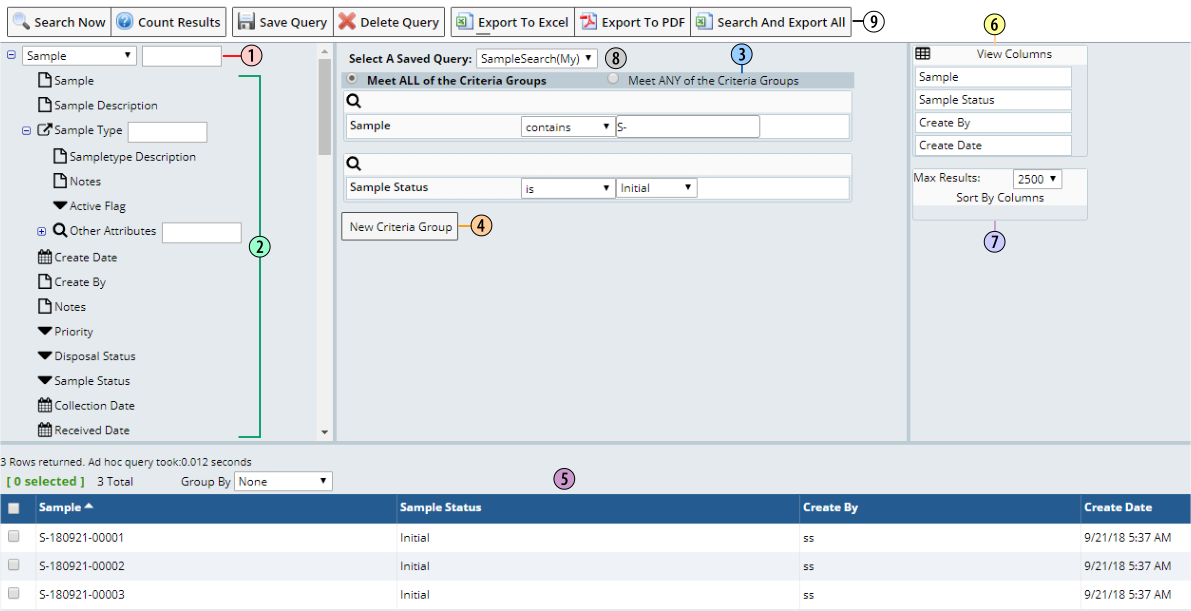
|
| Tools |
| Tool | Description | ||
| 1. | SDC Selector | This dropdown list contains all searchable SDCs. Choose
the SDC you want to query.
The input field on the root node and the expandable non-root nodes let you enter a few characters to filter searchable attributes.
|
|
| 2. | Searchable Columns | Searchable Columns
and relationships for the selected SDC.
To add a column, you can drag and drop the label (1) to the desired Criteria Group, View Columns, or Sort By. Alternatively, you can also click (2) to add to Criteria Group, (3) to add to View Columns, and (4) to add to Sort By Columns. |
|
| 3. | Criteria Group | Set of query conditions (described in Criteria Groups). | |
| 4. | New Criteria Group button | Creates a new Criteria Group. | |
| 5. | Returned Records | Records returned by the query. | |
| 6. | View Columns | Additional columns you want to show in the Returned Records list. | |
| 7. | Max Results and Sort By Columns | Lets you choose the maximum number of records to show in the Returned Records list, and the columns by which to sort. | |
| 8. | Select a Saved Query | Lets you open and edit a previously saved query. Only Shared queries are visible to other users. | |
| 9. | Toolbar | Page operations. |
| Relationship Display |
| Relationship | Display | ||||
Foreign Keys
|
Foreign keys in the SysColumn table are expandable to show searchable columns in the table with the primary key. | ||||
Reverse Foreign Keys
|
Must be added to the SysExtendedColumn table by adding an Extended Column. These display the single Extended Column. | ||||
Data Sets and Data Items
|
Partial identifier of Parameter List, Parameter, or Parameter Alias can be entered to display a list of matching Data Sets in the format specified by the AdHocQuery page configuration. The list is generated as you enter the identifier. Choose the Data Item to query. | ||||
SDI Documents
|
This shows SDI Documents (Documents associated with SDIs).
For information about configuring Document Fields to show in an Adhoc Query
page, see Adding
Document Fields in the AdhocQuery
Page Type.
The SDI Document Field is an expandable node with a search field. If the Fields are in Categories, expanding the node shows Categories; otherwise, only the Field is shown. All Fields must be predined (meaning you must create Field SDIs in the "Field Definitions" tramstop... not in a Form). Entering search text into the search field gets all matching fields and displays them directly under the Document Field node. Drag or double-click Document Fields to criteria and view columns.
|
||||
SDI Attributes
|
This shows SDI Attributes. For information about configuring Attributes to show in an Adhoc Query page, see Adding Attribute Fields in the AdhocQuery Page Type. |
A Criteria Group defines a set of query criteria that can be joined to:
| Meet ALL of the Criteria | AND operator (returns a record only if data satisfy all criteria). |
| Meet ANY of the Criteria | OR operator (returns a record if data satisfy any of the criteria). |
You can create multiple Criteria Groups with the New Criteria Group button:
| New Criteria Group | If you create multiple Criteria Groups, the
results of each group are joined by the AND operator. This returns a record only if data satisfy the results of all groups. |
Arguments are provided for each Data Type (String, Date, Number), SDIs, and RefTypes:
|
|
|||||||||||||||||||||||||||||||||||||||||||||||||||||||||||||||||||
|
|
||||||||||||||||||||||||||||||||||||||||||||||||||||||||||
|
|||||||||||||||||||||||||||||||||||||
| Button | Description | |
| Search Now | Runs the query. Alternatively, press the "Enter" key (to run the query after changes are made). | |
| Count Results | Shows the number of records returned. | |
| Save Query | Saves the query. | |
| Delete Query | Deletes the query. | |
| Export to Excel | Exports the returned records to an MS Excel spreadsheet. For a large number of records, use "Search and Export All". | |
| Export to PDF | Exports the returned records to an Adobe Acrobat PDF file. | |
| Search and Export All | Runs the query and exports the returned records
to an MS Excel spreadsheet in a single operation. Use "Search and Export
All" rather than "Export to Excel" when you must retrieve
thousands of records (up to 100,000 in Excel format). "Export to Excel"
actually renders the results in the Adhoc Query page. Such rendering can
consume enough memory to be problematic. Using "Search and Export All"
executes a direct export to file, so rendering is not an issue.
After clicking the button, a dialog offers the Excel export option (note the limits on the number of records) and shows the export status:
|
When returned results are grouped, the number of groups is shown along with the total number of returns in each group. Collapsing the groups continues to display the number of returns in each group.
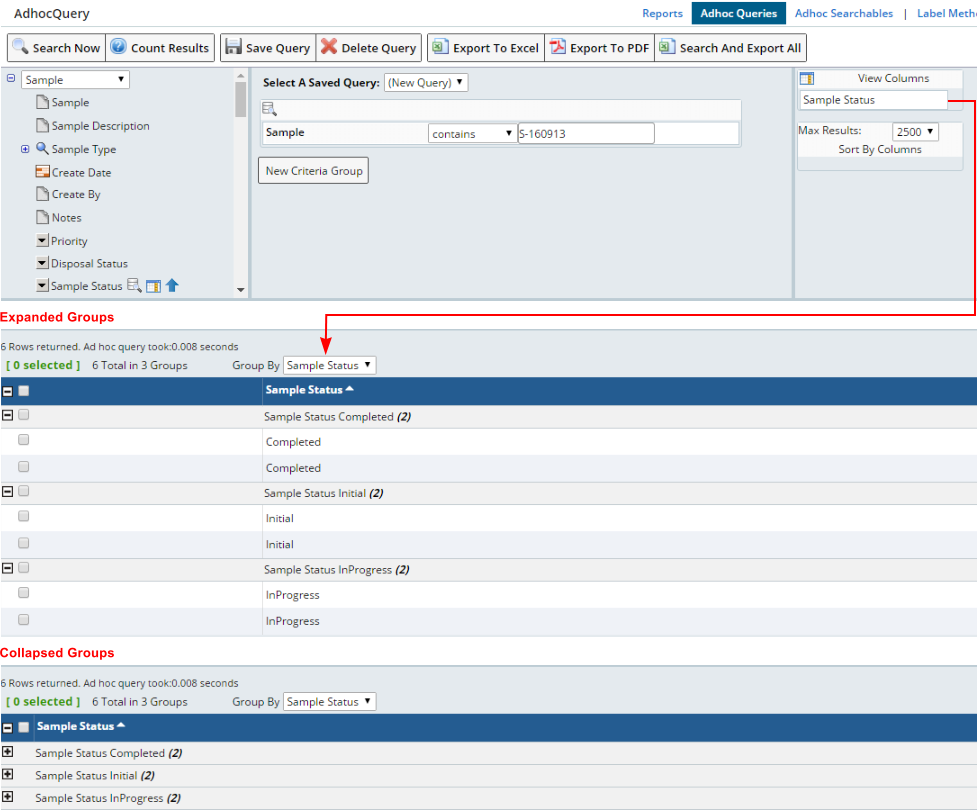
|
List Page Integration |
|
|
In List pages, you can:
| • | Build New Adhoc Queries
Click "Create Adhoc Query" on the relevant List page as shown below. |
| • | Run Saved Adhoc Queries
Saved queries automatically appear as a link on the relevant List page. |
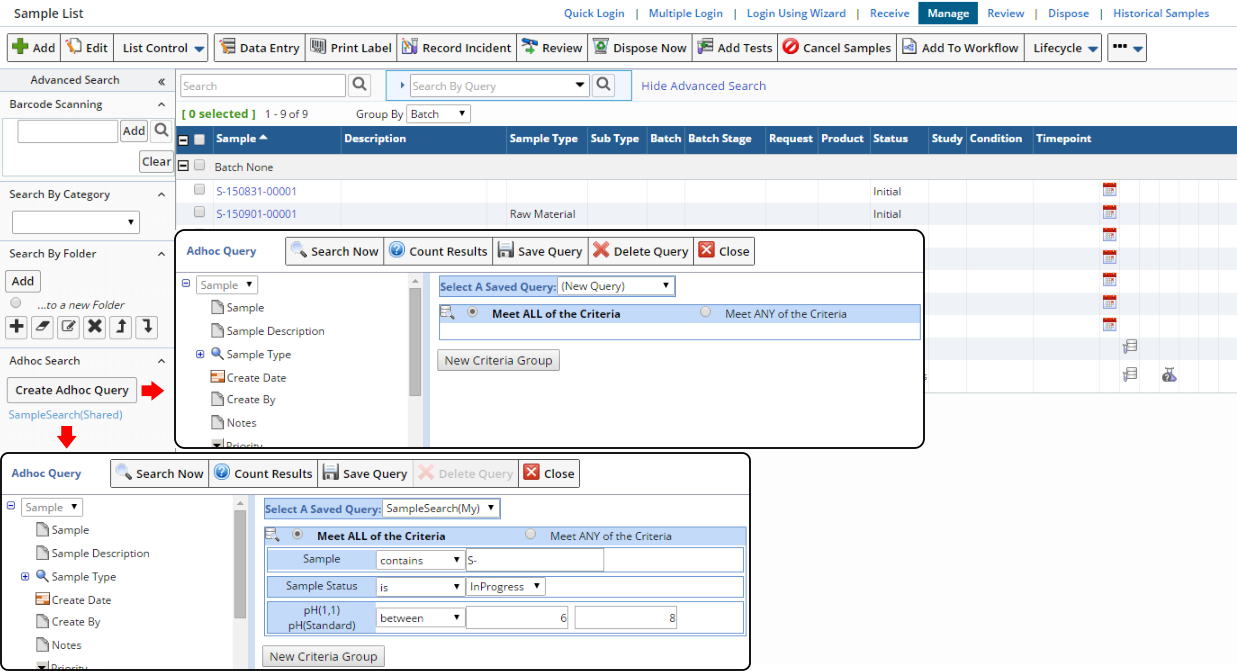
|
When SDIs are displayed in groups, the total number of returns in each group is shown. Collapsing the groups continues to display the number of returns in each group.
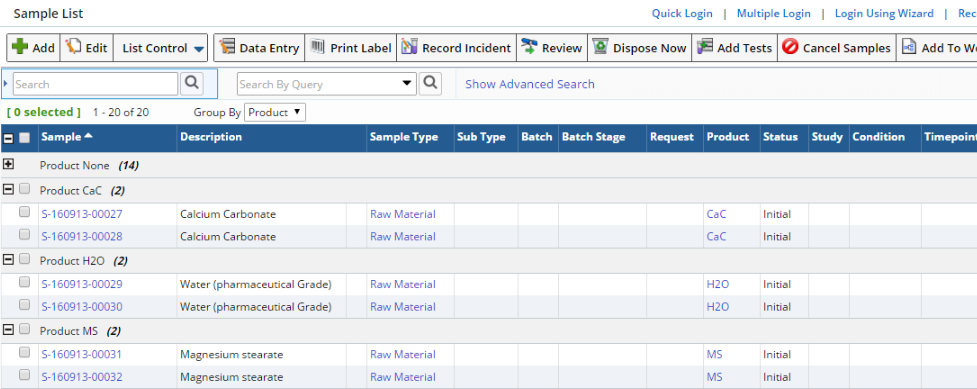
|
Creating Adhoc Query Pages |
|
|
Use the AdHocQuery Page Type to create an Adhoc Query page (see Basic Principles for information regarding page creation).
System Search Integration |
|
|
The System Search feature can be integrated into Adhoc Query pages. To do this:
| • | Setup Indexing and Searching per the Prerequisites for System Search. |
| • | Enable the "Show Text Search" property (and "Text Search title" if desired) in the AdHocQuery Page Type for the relevant Adhoc Query page. |
A "Text Search" field is inserted above the Adhoc criteria. This field can be used alone or in combination with other Adhoc Query criteria to narrow the search criteria. Values in this field are saved with the Adhoc Query.
In the example below, Sample is queried solely on the presence of "S-", which returns all Samples with an OOB automatically-generated key.
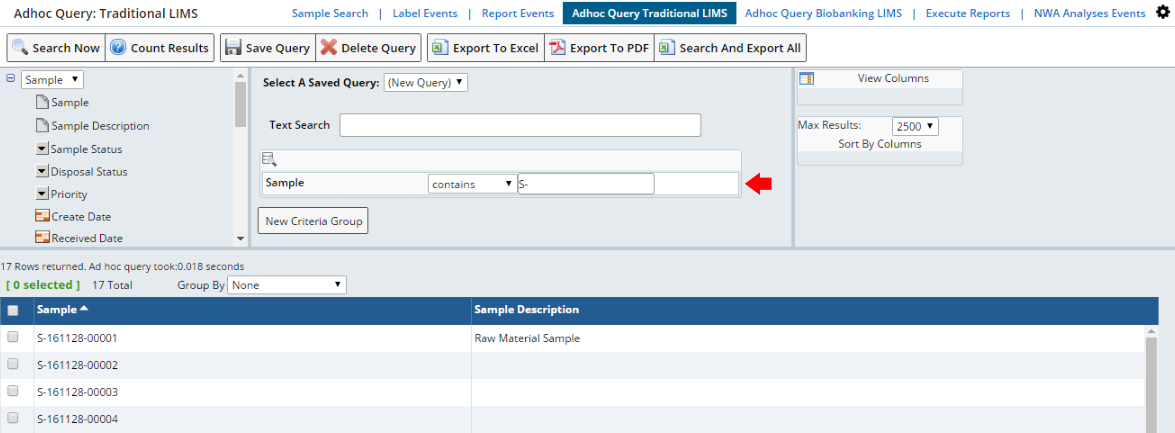
|
Text Search further narrows the search to all Samples containing S- and ending with the number 4 as shown below. Note the wildcard syntax (see System Search Options).

|
Text Search can also be used by itself, as in the example below.

|